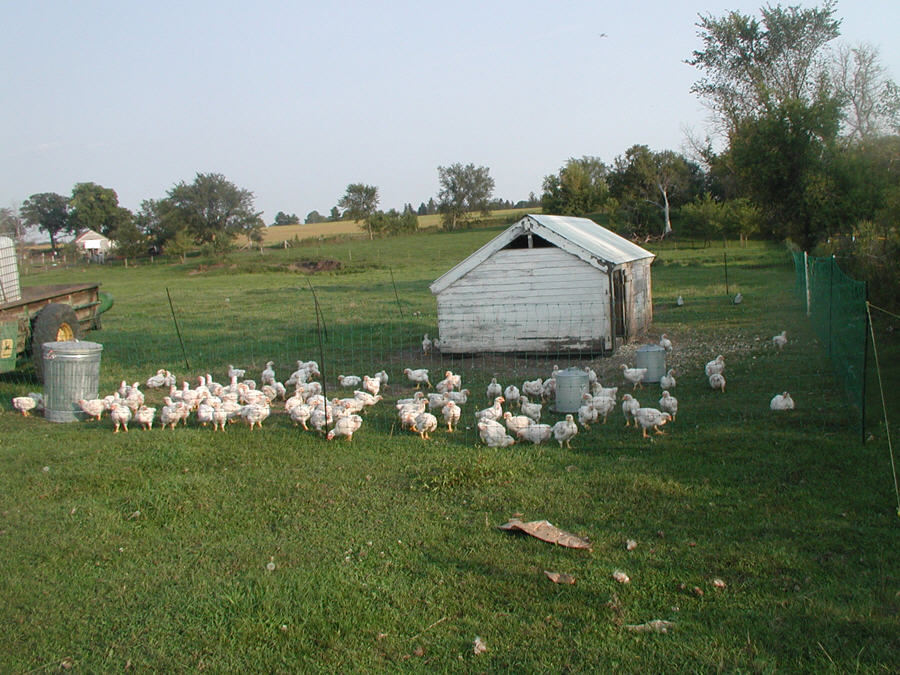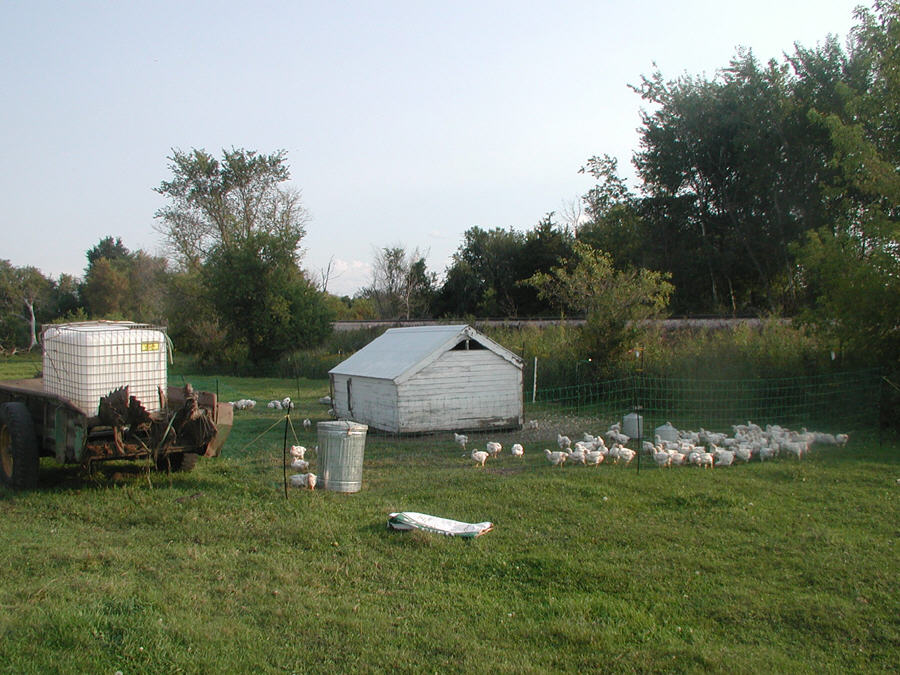Karl asked for a picture of our chicken setup. Karl, your wish is my command!


Karl did maybe not ask for the novel which follows, but unfortunately for him (and you) here it is anyway.
We bought the little insulated hog house on skids for our portable pasture chicken house. It measures somewhere around 7 x 11. In the past, when we’re done with broiler chickens for the year, we pull it back up to the barnyard and use it as winter housing for our sow and boar. Once it’s time to farrow we kick the boar out, make a temporary creep inside with a heat lamp, and the piglets are born in there. It’s a nice little multi-purpose building. Now that we have the the JLo’s we won’t be able to do that anymore. I think we paid around $200 for it.
The shed is surrounded by electric poultry netting, I think about 150′ of it. This is the 6th batch of birds we’ve used it on, but I don’t remember what we paid for it. This hooks into one of the 2 electric strands that runs the perimeter of our 10 acres of pasture. The only predator problem we’ve experienced so far, out of about 615 birds, is that on 2 occasions we’ve lost one to an owl. If you live in an area with a lot of “overhead” type predators, this might be more of a problem for you. Our neighbor told us he was out for a walk and saw 2 dogs running through our pasture. They ran up to that electric netting, touched a nose to it, yelped and ran away. And there was a steer that jumped the fence once but he was after the chicken feed, not the chickens.
We keep a metal garbage can inside the pen to store the feed. The lid is held on with a bungee cord. The water tank sits in the manure spreader and we run a garden hose from it to fill the waters, just a gravity flow setup. When the water is gone Matt pulls the spreader and all up to the house, fills it, and brings it back. The water tank was cheap, if not free.
The only thing missing from this picture is the tarp we usually set up. It attaches to the long side of the building, zip tied into fence staples set into the wood. The other side is zip tied to a piece of metal conduit bent into a 3-sided rectangle (if that makes any sense at all). The conduit is secured with tent stakes and string, providing the tension to hold the tarp up off the ground. On hot days we shut the birds out of the building, and the tarp provides shade while allowing fresh air and circulation they wouldn’t get inside the shed.
How often we move the whole setup depends on the condition of the grass. When the birds are little, we can go about 10 days. When they get bigger, or if we have a lot of rain, we have to move more like once a week. But by now we have the routine down, the family works as a team and it’s done in under an hour. We just take the fence down, drag it over to the next patch of grass, let the birds meander about until we’re ready, then herd them over to the new area and set the fence up around them.
One of the problems we’ve had is that they have to be taught to go inside the shed at night. I wasn’t vigilant about that this time, and last week we lost 5 broilers and poor little Chuck in a heavy overnight rain. If it’s daylight when it starts to rain they’ll seek shelter inside the shed, but when they’re already bedded down for the night they just pile up and die. But that was a preventable problem, as now they’re all going in at night on their own. It just takes a few nights of going out at sundown and herding them into the shed.
Why did we go with this setup over chicken tractors? First, almost all of our farm sits on a downhill slope. What doesn’t sits in the floodplain of the creek. It seemed like we would have a lot of problems with gapping around the bottom of the chicken tractor, sitting on rough sloping ground, and that this would be asking for predator problems.
Second, (and let me preface this by saying I’m not knocking anyone that uses chicken tractors!), chicken tractors just seemed a little too confined to us. I’m not talking subsidized, big ag CAFO confinement. But still, the chicken tractors we saw didn’t seem to us to provide enough space for them to really act their most chicken-y and get enough room to run and flutter about. Then again I could be totally wrong, seeing as how we never actually tried a chicken tractor setup. This setup is just what works for us.
I’ve been reading some Cornish Cross bashing on other blogs lately. I won’t go into all of the arguments, but honestly I just can’t identify with some of the comments calling these birds “Frankenblobs”. That just hasn’t been our experience. We find that they’re quite active, running, flapping their wings, vaulting themselves into the air in funny little practice cockfights. (“Cockfights” – that ought to get me some Google hits!) They have the room – both vertical and horizontal – to do that in this setup. We haven’t experienced “mushy” meat, either. Our meat is firm textured and seemingly low in fat, and I think it’s because they’re getting lots of exercise. Meat is muscle, after all, and muscle is built with use.
The rapid growth on these birds can come with its own set of problems, but by the 4th batch of 100 I’d learned a lot of tips and tricks to raising them (mostly by trial and lots of error) so that now we very rarely have leg problems, ascites or “flips”. But that’s another novel for another day, and anyway I’m still learning.
I will say you need to buy quality stock from a reputable hatchery. I’m fortunate, I live only miles from Hoovers Hatchery. I get to go in there to pick up my chicks and when I do I get to see a wonderful family business and the good, small-town hardworking people that have jobs in part because I buy my chicks there. I’ve also bought layer chicks there and had great success with them.
Here endeth the novel 🙂


We created a tractor out of a 6×6 dog pen. It worked great, though we decided for a permant structure and letting a few free-range.Just found your blog, and I’m loving it!
wow that is an operation. i imagine if we had an active electric fence we’d have gone a route similar to yours. on the terrain point we have our chicken tractor on a pretty good slope right now. we weight it down with big rocks that force it to follow the (hills and valleys) terrain. i do like your point that your method lets the chickens be more like chickens–which is important for us. thanks for the detailed response.